


 |
 |
 |
![]()

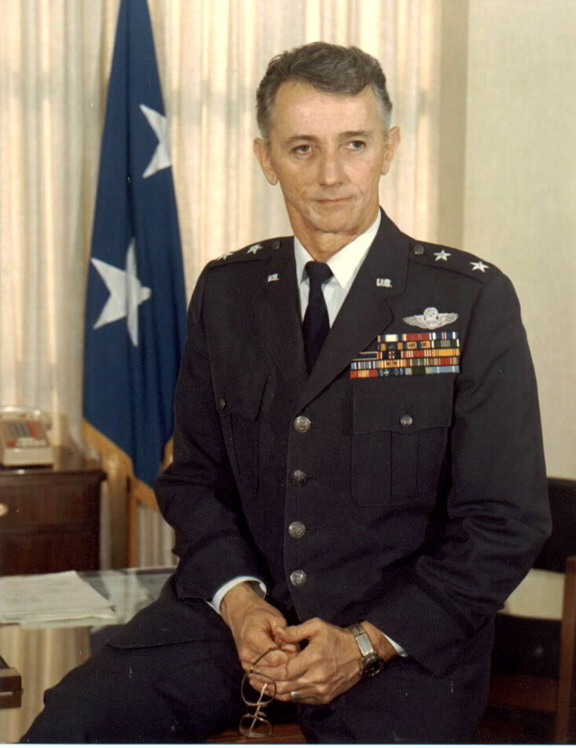



![]()
![]()
![]()
![]()
![]()
![]()
![]()
![]()
Retired Sep. 1, 1974
Major General Douglas T. Nelson was vice commander of the Aeronautical Systems Division, Air Force Systems Command, Wright-Patterson Air Force Base, Ohio. The division was responsible for research and development of all Air Force aircraft, engines, and missiles.
General Nelson was born in Astoria, Ore., in 1921. He graduated from high school in 1938, enrolled in Oregon State College in 1940, and as a member of the Oregon National Guard was ordered to active duty that same year. In May 1941 he entered Army Air Corps flying school and graduated in March 1942 with a commission as second lieutenant and his pilot wings.
He served an instructor in advanced pilot training at Stockton, Calif., and Roswell, N.M., until February 1943. After a brief tour of duty ferrying aircraft to Alaska, he went to the China-Burma-India Theater of Operations in June 1943 where he flew 590 combat hours. He returned to the United States in September 1944.
After a brief tour of duty as air evacuation pilot, General Nelson was separated from the U.S. Army Air Forces in 1946. He was employed as a commercial airline pilot until November 1947 when he received a Regular Air Force commission and returned to active duty.
He was assigned to the Strategic Air Command and served with the 33d Fighter Group at Walker Air Force Base, N.M., and during 1948 attended the Air Tactical School, Tyndall Air Force Base, Fla. From October 1948 until March 1949, he served as a 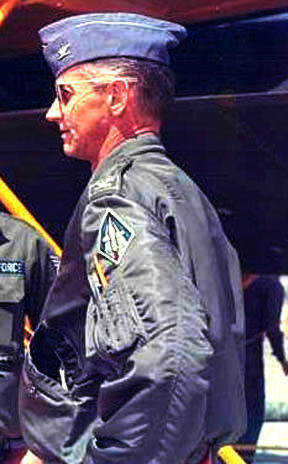 member of the United Nations Truce Force in Palestine. He then returned to Walker Air Force Base and was assigned to the 509th Bombardment Group where he became a lead crew aircraft commander. He and his crew represented the 509th Group at the Strategic Air Command bombing competition in 1949.
member of the United Nations Truce Force in Palestine. He then returned to Walker Air Force Base and was assigned to the 509th Bombardment Group where he became a lead crew aircraft commander. He and his crew represented the 509th Group at the Strategic Air Command bombing competition in 1949.
General Nelson joined the first class of SAC aircraft commanders to be trained as navigators, bombardiers and radar observers in 1950. After completing this training at Mather Air Force Base, Calif., in 1951, he was assigned to the 306th Bombardment Wing at MacDill Air Force Base, Fla., as an aircraft commander in the first B-47 squadron to achieve combat readiness.
He served at Strategic Air Command headquarters, Offutt Air Force Base, Neb., from June 1953 to February 1957, where he was assigned to the Tactics Branch and Systems Division, Directorate of Operations. He next went to Ellsworth Air Force Base, S.D., and was assigned to the 28th Bombardment Wing, a B-52 unit, and later to the 821st Air Division. In March 1960 he was transferred to Headquarters Fifteenth Air Force, March Air Force Base, Calif., as chief, Operations and Training Division, and in November 1961, was assigned to the 1129th Special Activities Squadron at Area 51 of the Nevada Test Site.
General Nelson went to Beale Air Force Base, Calif., in September 1964, for duty as director of plans, 14th Strategic Aerospace Division, and was involved in activating, equipping and training the first Air Force organization equipped with SR-71 aircraft, the 9th Strategic Reconnaissance Wing at Beale Air Force Base. He became vice commander, and then commander of the wing. In December 1966 he assumed command of the 14th Strategic Aerospace Division also at Beale Air Force Base. He returned to Headquarters Strategic Air Command as assistant deputy chief of staff for plans in August 1968.
General Nelson was assigned to Aeronautical Systems Division, Wright-Patterson Air Force Base, Ohio, in May 1970, as deputy director of the B-1 Program, in September 1970 assumed duties as system program director, deputy for B-1, and in January 1974 became vice commander of ASD.
His military decorations and awards include the Distinguished Service Medal, Legion of Merit, Distinguished Flying Cross, Air Medal with oak leaf cluster, Air Force Commendation Medal, Army Commendation Medal, Presidential Unit Citation Emblem, and the Air Force Outstanding Unit Award Ribbon. He has more than 10,000 hours of pilot time and holds a current airline transport pilot rating.
He was promoted to the grade of major general effective Feb. 26, 1971, with date of rank June 8, 1968.
From the time he was old enough to whittle a piece of wood into an airplane, Doug Nelson wanted to fly. In 1930 at the age of nine Nelson got his first airplane ride. "My mom bought me a ride for $5.00 in an old Waco off the beach in Seaside, Oregon," he said. "I was just high enough to look out the window after the pilot put seat cushions under me." It was a ride that would impact the rest of his life. "I will never forget getting up there and all of a sudden looking down at the trees, looking out at the ocean- that just did it for me."
A few years after that memorable first flight he began taking lessons. "I was learning from a World War I Navy pilot," he said. "Boy was I impressed-he was a great instructor." Nelson soloed on his 16th birthday in an E-2 Taylor Cub on a rainy day over a grass strip in Oregon. "I'll never forget it," he said. "I got my student pilot's license even before I got a license to drive a car," he said.
The decades to follow were filled with adventure and accomplishments for Nelson. He would serve our country in countless ways. His duty brought him to several parts of the world, including the Middle Eastern desert, Alaska, the China-Burma theater during World War II, the rolling green hills of California and the southwestern deserts.
Nelson became a member of the Oregon National Guard and enrolled at Oregon State in 1940 as an aeronautical engineering major. After only a week of school he was called to active duty. "I got my orders and had to go to Fort Lewis, Washington," he said. As soon as he was old enough he took the two-day written exam that was equivalent to their two-year college entrance requirement and passed his physical. He waited to be called for pilot training. That call came in July 1941. "It was one of the greatest things that could ever happen to a young guy--going to pilot training," he said.
In December 1941 the entire world would change forever when Pearl Harbor was attacked. "Most of us who were already in uniform were quite aware there was going to be a war," he said. "It was no real big surprise to us, but of course, it still made a very dramatic impact. We did what we were called to do."
In those days pilot training was not as formal as it is now and Nelson was called to ferry P-39's to Fairbanks, Alaska. "One day me and another pilot went out to the airplane," he said. "He told me how to open the canopy and how to start the plane. I sat in it and looked around for about an hour, then the next morning I took off for Alaska." After his brief tour ferrying the planes Nelson went to the China-Burma-India Theater of Operations where he flew 590 combat hours, primarily in C-46's before returning to the states in September 1944.
In 1946 after a tour of duty as a fighter aircraft instructor pilot, Nelson was separated from the U.S. Army Air Forces. He served as a commercial airline pilot, flying DC-3's with West Coast Airlines until November 1947 when he received a regular commission and returned to active duty. He was assigned to Strategic Air Command and served with the 33rd Fighter Group and attended Air Tactical School in Florida.
From October 1948 to March 1949 Nelson was sent to Palestine as part of the United Nations Truce Force. While there he sometimes relied on camels as his mode of transportation with the Syrian Camel Corps. He then returned to the states and became a B-29 lead crew Aircraft Commander at Walker Air Force Base, New Mexico.
Nelson joined the first contingent of SAC Aircraft Commanders to be trained as navigators, bombardiers and radar observers in 1950. After completing this training at Mather Air Force Base, Calif. in 1951 he was assigned to the 306th Bombardment Wing at MacDill Air Force Base, Fla., as an Aircraft Commander in the first B-47 squadron to achieve combat readiness.
He served at Strategic Air Command headquarters, Offutt Air Force Base, Neb., from June 1953 to February 1957 where he was assigned to the Tactics Branch and Recon Division, Directorate of Operations. In 1956 he was assigned as SAC Project Officer to provide all needed support to the CIA U-2 Program.
During the Cold War the general public was not aware of some of the dangerous missions Nelson and others like him flew, including those in the B-52 Stratofortress. At Ellsworth Air Force Base, S.D., Nelson was Chief of Training of the 28th Bombardment Wing.
"At Ellsworth we were being equipped with brand new B-52's," he said. "We weren't combat ready, we were still training crews and suddenly we were put into airborne alert." Each plane carried four thermonuclear weapons. "We had four targets assigned in Russia," he said. "I found myself with non-ready crews who had rarely flown together. Here we were at airborne alert flying over the Polar Ice Cap just outside Soviet defenses. This was routine for SAC. In our case we weren't ready to do that but they said we were going to do it anyway and "good luck." They said we were going to fly 18-hour missions as often as needed. I remember flying sometimes two or three of those a week. It went on for three months," he said. "The general public didn't know that was going on at that time," he said.
In March 1960 he was transferred to Headquarters Fifteenth Air Force, March Air Force Base, Calif., as chief, Operations and Training Division, and in November 1961, was assigned to Headquarters U.S. Air Force with duty station in Las Vegas, Nev. (aka Groom Lake). Nelson was Chief of Operations of an Air Force Unit supporting the Oxcart (A-12) program.
Groom Lake, north of Las Vegas was already a hub of activity with the U-2 program. Amid the wildlife, tumbleweeds and desert winds a new system was to be tested that could go higher and faster than the U-2. The A-12, a sleek Mach 3, highly swept delta-winged aircraft would set the stage for swift reconnaissance over hot spots around the globe during the Cold War.
"I spent three years at Area 51 during the program," Nelson said. "It was a fun job. We had eight F-101's out there for chase and pilot proficiency training for CIA pilots." Nelson flew in the A-12 trainer. "It certainly was a different world in that aircraft."
The world was going through tense times during those years and the most significant was the Cuban Missile Crisis in October 1962. The Soviet Union had attempted to place nuclear missiles in Cuba aimed at the United States. The entire nation was on alert as families prepared themselves by building bomb shelters and doing "duck and cover" drills at schools.
Although the A-12 was first test flown in April 1962, during the time of the crisis it was not ready for operational missions. "We were really getting a lot of pressure to fly the A-12 over Cuba," Nelson said. "But the engines and cameras weren't ready." "We were still at the beginning of the program. We were being called and asked, "When are you guys going to be ready" We want you."
In December 1964 the SR-71 a new, modified, heavier system capable of carrying more camera equipment was test flown at Edwards Air Force Base. At the beginning of the program Doug Nelson was given the task of finding the men to fly this sleek and mysterious aircraft for the 9th Strategic Reconnaissance Wing at Beale Air Force Base in California. Nelson and Ray Haupt ferried the first SR-71 trainer to Beale in January 1966. "I was the first person on the base for what became the 9th SRW," he said. "My job was to activate it and man it." In December 1966 he assumed command of the 14th Strategic Aerospace Division also at Beale. Nelson said it was an unbelievable time for him. "It was a once in a lifetime experience to be commander and start the program at Beale," he said. "Word got around very fast that I was looking for people like B-58 pilots, fighter pilots and those with flight test experience. I began to get calls from all over the Air Force," he said. "When I found potential candidates from other bases I would call their Wing Commander and tell him I wanted to come in to interview people for a highly classified program." It was an intense experience for potential pilots and crewmembers, but those who have served with the program say it was the most important part of their careers.
The SR-71 served our country well and had never been shot down by enemy fire. Unfortunately it would be forced into an early retirement in 1990.
In the meantime Nelson was assigned to Wright Patterson Air Force Base and became Air Force Program Director, B-1 Strategic Bomber until January 1974. He was named Vice-Commander, Aeronautical Systems Division where he remained until his retirement from active duty that same year.
When the SR-71 program was to be terminated, Nelson went to the Pentagon to meet with General Larry Welch, the Air Force Chief of Staff, to see if the program could be saved. "They were all hooked on overhead space reconnaissance systems," Nelson said. "In their opinion they didn't need a manned system other than the U-2." At the time the Cold War was winding down, but not over yet. Welch told Nelson: "With what I would have to put in my budget every year to support the SR-71 program, I could buy and support a wing of F-16's." Welch believed the overhead reconnaissance systems were totally adequate, Nelson added.
Nelson always felt the SR-71 was a one of a kind and we won't see another manned system like it.
His life seemed to have come full circle while living in Page, Arizona. He served as a back up pilot for the National Park Service from 1978 to 1999 at Lake Powell. "There are dirt strips and airports all around the lake-there are no roads and the only way to get park employees someplace was by airplane," he said.
Before his death he was in the process of building a full-scale replica from original factory drawings of a 1927 Curtiss Hawk.
Nelson was inducted into the Arizona Aviation Hall of Fame in April 2004 and the Blackbird Laurels Society in May of the same year.
He was a member of the National Aviation Hall of Fame (NAHF) Board of Nominations.
Note: he told me in our interview that he nominated Ben Rich for enshrinement. Mr. Rich will be posthumously enshrined at this year's National Aviation Hall of Fame ceremony in Dayton, Ohio.
With more than 14,000 pilot hours, Nelson flew 148 types of aircraft. Of all those aircraft he said, "The SR-71 was my favorite."
His military decorations and awards include the Distinguished Service Medal, Legion of Merit, Distinguished Flying Cross, Air Medal with oak leaf cluster, Air Force Commendation Medal with three oak leaf clusters, Army Commendation Medal, Presidential Unit Citation Emblem, the Air Force Outstanding Unit Award Ribbon, Asiatic-Pacific Theatre Medal with two Battle Stars and the China War Memorial Medal. 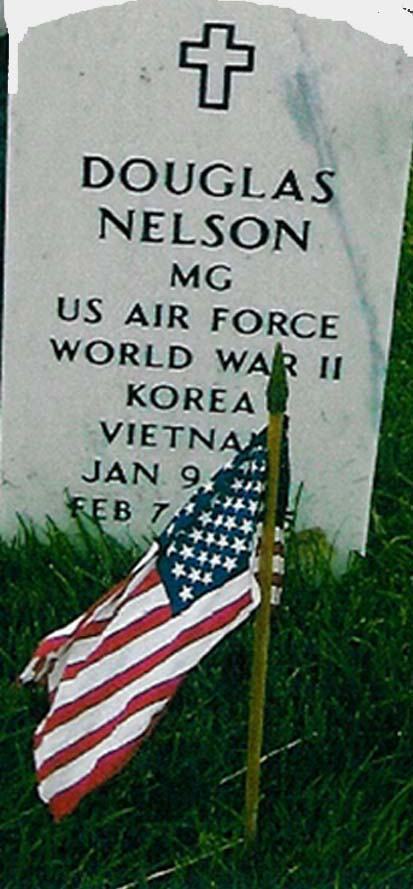
Major General Douglas T. Nelson, USAF, (RET.) was interned with Full Military Honors at Arlington National Cemetery on March 4, 2005
Author's note: I wear an SR-71 lapel pin everyday on the job. At least once a day, I come in contact with a person that comments on it. They ask, "Were you in the Air Force" How do you know about that plane" I tell them I knew some of the people involved in the program. I get so many comments from people saying what a great plane it was and there will never be anything like it.
Well, as mighty as the Blackbird family of planes is, nothing compares to the people involved. Most of you who read this were involved with the A-12, U-2 or SR-71 programs. I was just a child when the A-12 first flew in 1962 and wasn't even born when the first U-2 was flown. Now with my interest in this remarkable program and its people, it still amazes me that these aircraft were flying high above us without our knowledge, protecting us.
I am so thankful I had the opportunity to spend an afternoon with Major General Nelson and his lovely wife, Claudine, in Phoenix, Ariz. I will never forget our conversation and will always be grateful to General Nelson and all those who served our country during such a significant part of our history.
####
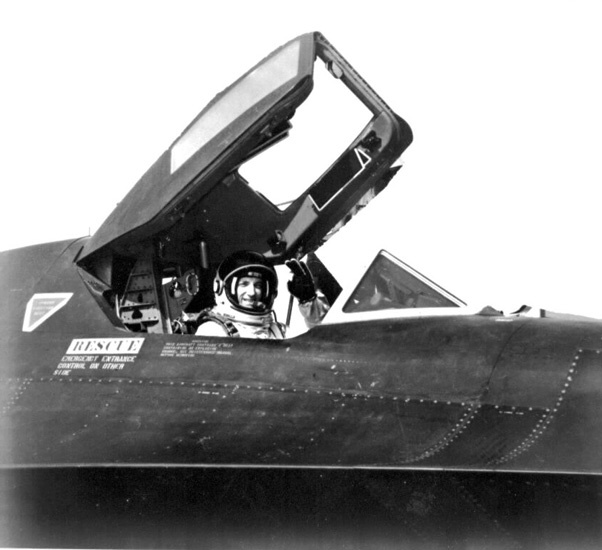
Col Nelson preparing for a Functional Check Flight in an SR-71 at Mach 3.2
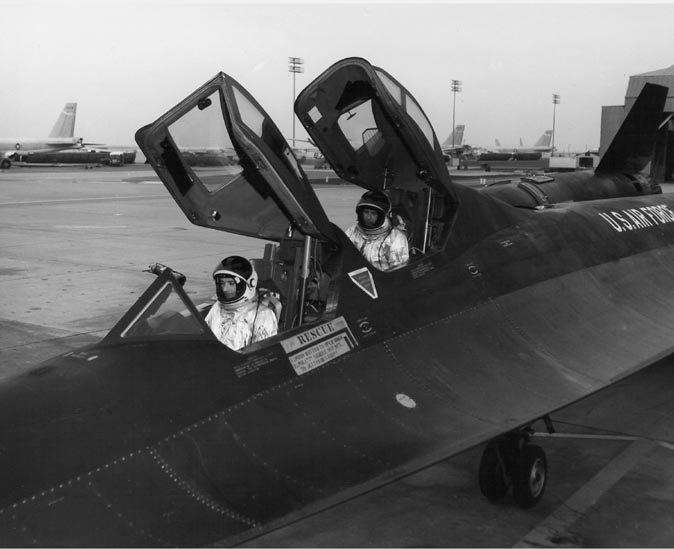
Gen Nelson and Col. Ray Haupt
Photo donated by Colleen Pryor and grandson Brad Poppell
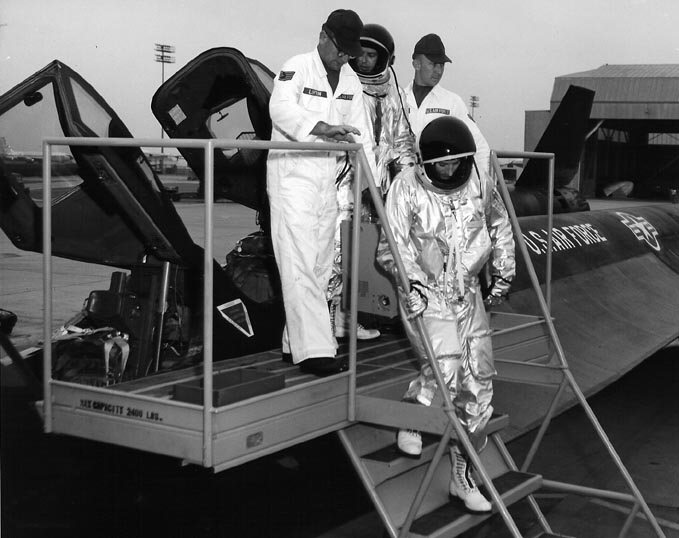
Gen Nelson and Col. Haupt
Photo donated by Colleen Pryor and grandson Brad Poppell
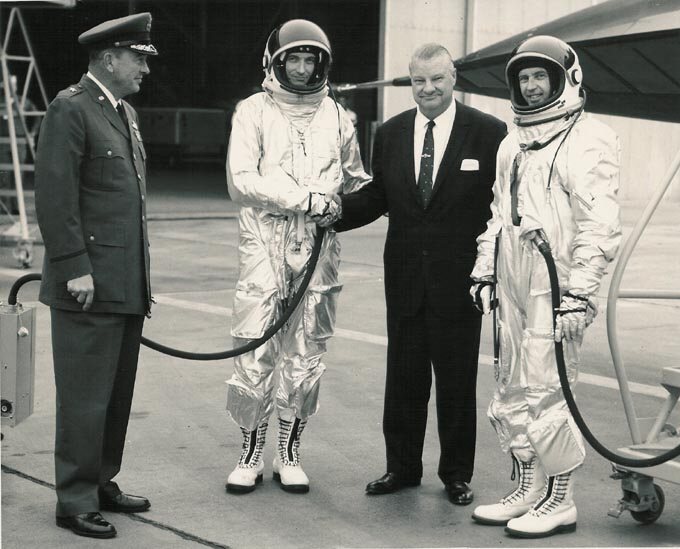
L-R: Gen. Deportes, Gen Nelson, Kelly Johnson, and Col. Haupt
Photo donated by Colleen Pryor and grandson Brad Poppell
 Douglas T. Nelson, Major General, USAF (Ret) was inducted into The Arizona Aerospace Foundation's Arizona Aviation Hall of Fame on Saturday, April 3, 2004.
Douglas T. Nelson, Major General, USAF (Ret) was inducted into The Arizona Aerospace Foundation's Arizona Aviation Hall of Fame on Saturday, April 3, 2004.
This was a state-mandated program administered by The Pima Air and Space Museum, Tucson, Arizona, and its Foundation. It is the highest honor that can be bestowed by The Foundation and is reserved for those who have made outstanding contributions to aviation and to Arizona. The induction ceremony and dinner was held on April 3 at the Pima Air and Space Museum, 7000 East Valencia Road, Tucson. It is notable that of all the Honorees, only Generals Nelson and Haupt were associated with the SR-71 program.
On April 2-3, 2004, the museum also hosted the eighth SR-71 Blackbird Symposium, "Keeping The Spirit Of The SR-71 Blackbird Alive," to coincide with Doug's induction.
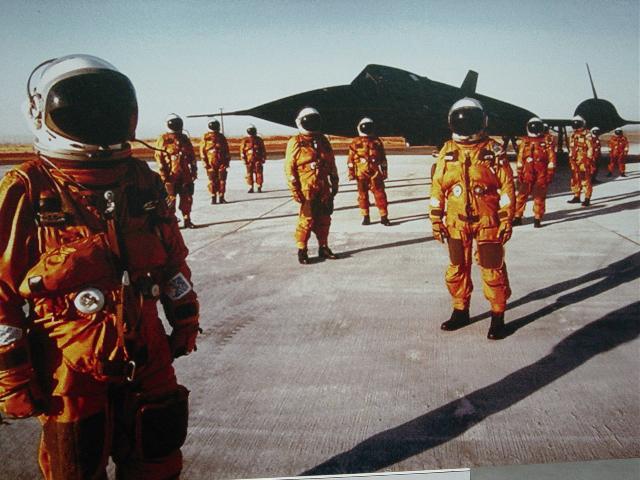
Pima Air Museum, Tucson, AZ 3 April 2004

|

|

|

|

|

|

|

|

|

|

|

|

|

|

|

|

|

|

|

|

|

|

|

|

|

|

|

|

|

|

M/Gen Doug Nelson, USAF (Ret) died at noon today in the Good Samaritan Hospital in Phoenix, Arizona. Our prayers go out to Claudine and family, and to General Nelson's Roadrunner brothers and sisters for their loss of a great leader and loving father. General Nelson will be interned in the Arlington Cemetery on March 4th at 11:00 AM. Family and friends of the deceased should arrive at the cemetery in their private vehicles or in vehicles provided by the funeral home. These vehicles will be needed to go to the gravesite or the Columbarium for the services. The cemetery does not provide transportation. 3-1-2005 Update Claudia reports that she intends to video the internment for showing at a memorial ceremony to be held at the high school auditorium in Page, Arizona on March 18th at 3:00.
 |
 |
 |